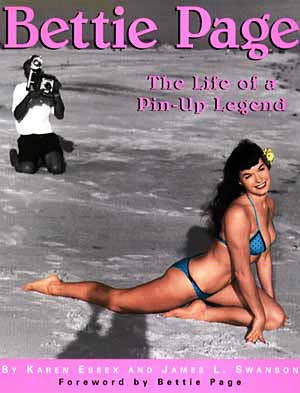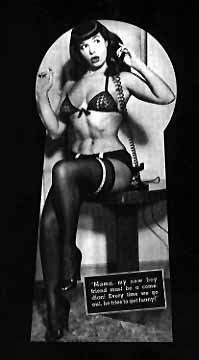

















| Bettie Page's Life Story Finally Told by Gary Johnson | |
|
For nearly four decades, Bettie Page was a complete mystery. A legend who just suddenly disappeared at the height of her popularity as a pin-up model. No one seemed to know exactly what happened to her. At one time she graced the covers of a multitude of men's magazines in the '50s. And then, all at once, she was gone. But her legend wouldn't die. | |
Alternately appearing as the sweet girl next door and as a sexy S&M vamp (complete with whips and leather accouterments), her photographs forever burned her image onto the minds of her fans. As a result, even forty years after her disappearance, Bettie Page never faded away. A legion of fans kept her flame burning, retreading a variety of rumors that attempted to explain her disappearance.
When Dave Stevens drew her likeness as one of the central characters of The Rocketeer, a whiz-bang comic book about the adventures of a jet-suited do-gooder, a whole new generation of fans emerged, clamoring for more information about her. Fan magazines sprang up and dozens of picture books appeared. But the mystery continued, what happened to Bettie Page? Who was she? And what was she really like?
Well, the mystery slowly unfurled over the past few years and she finally allowed word to creep out that she in fact was still alive, now well into her sixties. But she tenaciously held onto her seclusion, avoiding the waves of fans eager to bow at her feet. With dozens of writers begging to tell her story, if she would only grant interviews, Bettie Page finally relented and chose to meet with two writers, Karen Essex and James L. Swanson, about writing her biography. And now, at long last, her story is told.
The photographs of her family life come as a revelation, allowing us to finally see her as a complete person instead of just the object of wide-eyed stares. We see Bettie with her mother, sisters, and brothers and a variety of boyfriends. We see her sitting on the stoop with neighborhood kids, dancing like a chorus girl with her sister Goldie, and posed with her fellow students in high school photos (she was voted "most likely to succeed").
The text that accompanies the photographs rigidly sticks to the facts without any theorizing about the Bettie Page image and the effect it wreaked on the libidos of men around the world. Instead, the text plainly and flatly gives us everything about Bettie that the authors could dig up, including dozens of interviews with photo club members and old boyfriends.
Her photographers voice in unison how easy Bettie was to work with. No matter how poor the lighting, how shoddy the sets, or how cold the ocean surf, Bettie always came to life when the camera shutters were clicking.
Disappointingly though, the authors fail to describe how Bettie Page was finally rediscovered. Instead of playing her rediscovery as a mystery revealed, the authors flatly state that she was featured on Life Styles of the Rich and Famous and then the mystery was over. Why Life Styles? How did they get the inside story on Bettie? Was a reporter responsible for ferreting out her whereabouts? Don't look to this book for an answer to any of these questions. As a result, the book fails to capitalize on the inherent drama present in her life.
But even with its shortcomings, the book is still a revelation, finally allowing us to hear Bettie speak about her own life ("From the first time I posed nude, I wasn't embarrassed"), about the troubles she faced ("We were so poor that we were lucky to get an orange in our Christmas stockings") and about the reasons that she suddenly gave up her modeling career (a combination of overzealous fans stalking her and the added pressures of senate investigations into pornography). And its doubly hard to complain about any book packed with such astonishing photos as the ones you'll find in this book.
Bettie was truly one of a kind, imbuing her every pose with an energy and excitement that must be seen to be fully appreciated. In some pictures, she becomes the personification of the girl next door, all gentle smiles and graceful poses, whether she's frolicking in the surf while wearing a teensy bikini or posing buck naked in starkly-lit studios for camera enthusiasts. (Buck Henry, who was present at some of the camera club photo shoots, suggests that many of the photographers didn't even have film in their cameras.) And in other photos she becomes the dark angel of S&M fantasies, cracking a whip while her eyes take on a fire absent from her good girl poses. This schism in her character and how easily she moved back and forth between the two different personas is largely responsible for her fame. If she was just one or the other, she would have been remembered but not in the same way. In keeping with the '50s attitudes toward sex, Bettie Page broke sex into two opposite categories--the easily available (hey, here's the girl next door) and the secretly naughty and wicked. No other performer has captured this schism of attitudes so clearly and forthrightly.
Bettie Page: The Life of a Pin-Up Legend by Karen Essex and James L. Swanson, General Publishing Group, Inc. $40, hardcover. |
 |
 |
 |
 |
 |
 |

 The resulting book, Bettie Page: The Life of a Pin-Up Legend, is a lavishly illustrated paean for her legions of fan. Crammed with hundreds of photographs from periods throughout her career, the book is the definitive tome on the subject. In addition to the expected cheesecake and nudie shots, the book contains many personal photographs from Bettie's own collection, allowing us to see Bettie from many periods throughout her personal life, from her hard early family life in Tennessee through the early '70s. At that point, the photos stop and Bettie's anonymity today is assured. She writes in the book's foreword,
The resulting book, Bettie Page: The Life of a Pin-Up Legend, is a lavishly illustrated paean for her legions of fan. Crammed with hundreds of photographs from periods throughout her career, the book is the definitive tome on the subject. In addition to the expected cheesecake and nudie shots, the book contains many personal photographs from Bettie's own collection, allowing us to see Bettie from many periods throughout her personal life, from her hard early family life in Tennessee through the early '70s. At that point, the photos stop and Bettie's anonymity today is assured. She writes in the book's foreword,